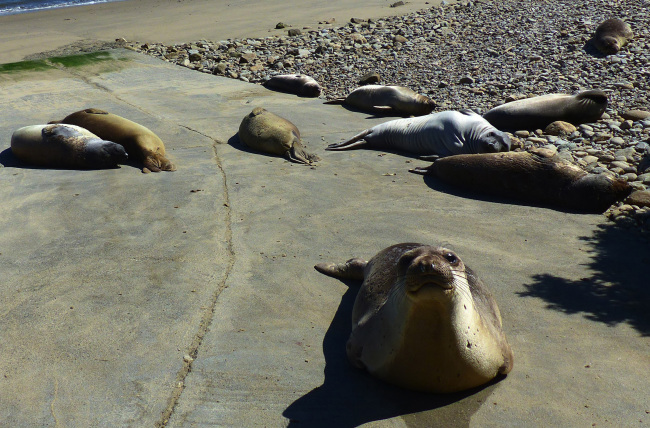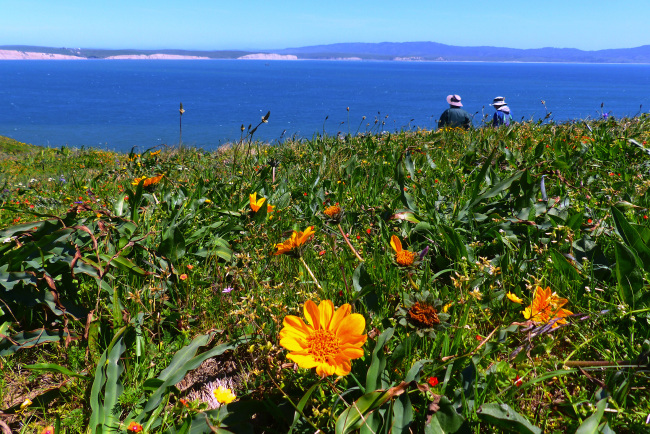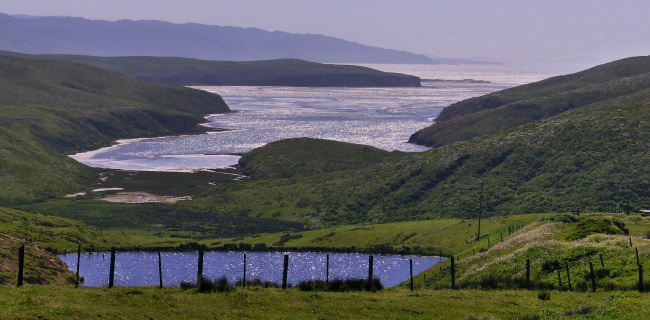Flee crowded San Francisco for the serenity of Point Reyes
By Korea HeraldPublished : Nov. 11, 2016 - 13:12
POINT REYES NATIONAL SEASHORE, California -- You’re in San Francisco and need a break from clanging cable cars and overpriced hotels? Break for the beach. Point Reyes is an hour and a world away.
Before leaving home, sign up for a plein air pastel workshop with an overnight stay in a historic former Coast Guard lifeboat station hanging over the azure bay where Sir Francis Drake anchored in 1579. It’s just one of dozens of regular offerings by the park’s Field Institute. Awake to sea lions barking just a belly flop from your door.
Go in spring, when wildflowers turn oceanfront headlands into a garden of blue and yellow lupine, starburst Goldfields daisies, purple Douglas iris, creeping blue-blossom and dainty baby-white-eyes.
Go to see the rare Tule elk or bobbing coveys of quail, spectacular views of ocean and sky, and the 1870 lighthouse that helped guide ships down the coast toward the Golden Gate.
Or just go to decompress.
“You get to Point Reyes and it’s so spread out, with 70,000 acres (283 square kilometers), you can be right next to one of the great metropolises on the West Coast and still get a sense of wilderness,” says Tyler Vaughn, who directed the Field Institute for Point Reyes National Seashore Association, the park’s nonprofit educational partner, when I visited last spring.
Before leaving home, sign up for a plein air pastel workshop with an overnight stay in a historic former Coast Guard lifeboat station hanging over the azure bay where Sir Francis Drake anchored in 1579. It’s just one of dozens of regular offerings by the park’s Field Institute. Awake to sea lions barking just a belly flop from your door.
Go in spring, when wildflowers turn oceanfront headlands into a garden of blue and yellow lupine, starburst Goldfields daisies, purple Douglas iris, creeping blue-blossom and dainty baby-white-eyes.
Go to see the rare Tule elk or bobbing coveys of quail, spectacular views of ocean and sky, and the 1870 lighthouse that helped guide ships down the coast toward the Golden Gate.
Or just go to decompress.
“You get to Point Reyes and it’s so spread out, with 70,000 acres (283 square kilometers), you can be right next to one of the great metropolises on the West Coast and still get a sense of wilderness,” says Tyler Vaughn, who directed the Field Institute for Point Reyes National Seashore Association, the park’s nonprofit educational partner, when I visited last spring.

Stay at the park’s hostel or bring a backpacking tent and really go wild with an overnight at one of four hike-in campgrounds, called Sky, Glen, Coast and Wildcat.
Vaughn guided me on a day tour of the park, which was established under President John F. Kennedy in 1962, not long after he signed into creation Cape Cod National Seashore. Some say Point Reyes was Kennedy’s offering to West Coast constituencies in return for saving the beach in his own Massachusetts backyard.
Point Reyes was worth saving. This giant semicolon of land, right on the hinge of the North American continent where the San Andreas Fault runs through narrow Tomales Bay and the nearby Olema Valley, is home to lagoons and bluffs, historic ranches and salty estuaries. Roughly 240 kilometers of trails crisscross the pasture, chaparral ridges, California-laurel valleys, meadowlands and windblown forests of Douglas fir and rare bishop pine.

“It’s like Brigadoon, it just sort of rises from the mist,” says Donna Faure, PRNSA’s associate director, who lives in the point’s adjoining bayfront village called, appropriately, Inverness.
“The point is known as an island in time,” Faure says. “It’s on a different tectonic plate,” with different plants and animals than you’ll see a couple miles away.
Vaughn led me through the old lifeboat station with its scarlet-red roof, edging Drakes Bay in the shadow of Chimney Rock. In 1927 this facility replaced an earlier lifeboat station that operated in the late 19th century on the ocean-beach side of the point, the site of many mishaps caused by wind and pounding surf. Drakes Bay was a more protected location, where a 11-meter motorized lifeboat was launched on a long marine railway. The station closed in 1968 after improved navigation reduced the number of shipwrecks.
Today, participants in overnight field trips can sleep in bunks in rooms with creaking wooden floors, some of the original old signage such as “Radio Room,” and old paned windows looking out on spectacular saltwater views.

Take a walk on the park’s Earthquake Trail for some education about California’s shaky ground. A line of blue posts at one point delineates where the earth split open along the path of the San Andreas in the famous 1906 earthquake.
This is where the Pacific and North American continental plates meet. The Point Reyes peninsula rides on the eastern ridge of the Pacific Plate, which advances northwestward. That’s why rocks of this craggy coast match rocks in the Tehachapi Mountains, more than 498 kilometers to the south.
So don’t wait too long to visit, or Point Reyes will end up in Alaska, fans of tectonics like to say. (Tribune Content Agency)
By Brian J. Cantwell
The Seattle Times
-
Articles by Korea Herald








![[Graphic News] More Koreans say they plan long-distance trips this year](http://res.heraldm.com/phpwas/restmb_idxmake.php?idx=644&simg=/content/image/2024/04/17/20240417050828_0.gif&u=)
![[KH Explains] Hyundai's full hybrid edge to pay off amid slow transition to pure EVs](http://res.heraldm.com/phpwas/restmb_idxmake.php?idx=644&simg=/content/image/2024/04/18/20240418050645_0.jpg&u=20240419100350)






![[From the Scene] Monks, Buddhists hail return of remains of Buddhas](http://res.heraldm.com/phpwas/restmb_idxmake.php?idx=652&simg=/content/image/2024/04/19/20240419050617_0.jpg&u=20240419175937)

![[KH Explains] Hyundai's full hybrid edge to pay off amid slow transition to pure EVs](http://res.heraldm.com/phpwas/restmb_idxmake.php?idx=652&simg=/content/image/2024/04/18/20240418050645_0.jpg&u=20240419100350)

![[Today’s K-pop] Illit drops debut single remix](http://res.heraldm.com/phpwas/restmb_idxmake.php?idx=642&simg=/content/image/2024/04/19/20240419050612_0.jpg&u=)